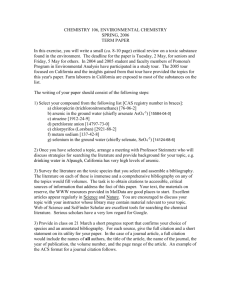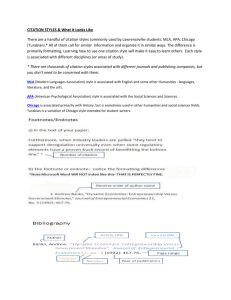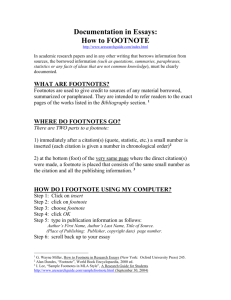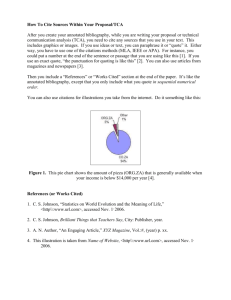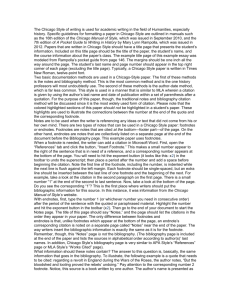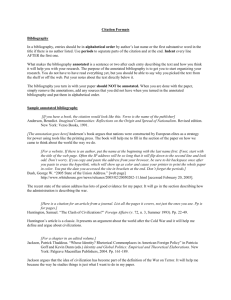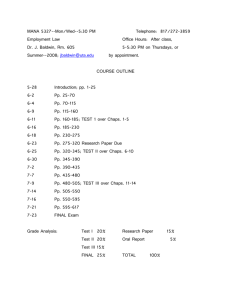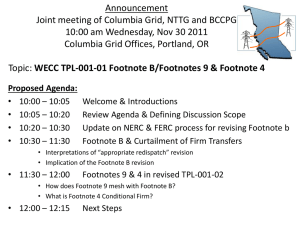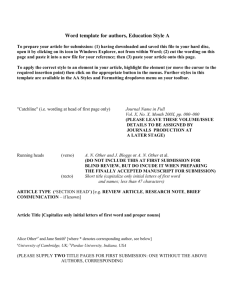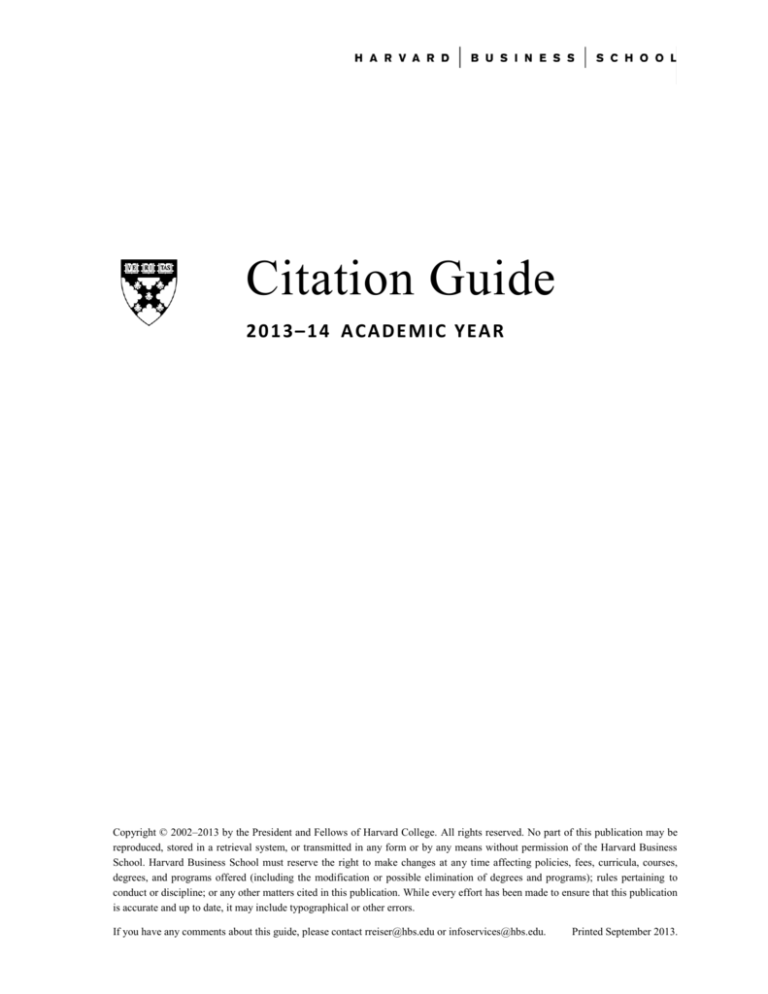
Citation Guide
2 0 1 3 – 1 4 A CA DE M IC YEA R
Copyright © 2002–2013 by the President and Fellows of Harvard College. All rights reserved. No part of this publication may be
reproduced, stored in a retrieval system, or transmitted in any form or by any means without permission of the Harvard Business
School. Harvard Business School must reserve the right to make changes at any time affecting policies, fees, curricula, courses,
degrees, and programs offered (including the modification or possible elimination of degrees and programs); rules pertaining to
conduct or discipline; or any other matters cited in this publication. While every effort has been made to ensure that this publication
is accurate and up to date, it may include typographical or other errors.
If you have any comments about this guide, please contact rreiser@hbs.edu or infoservices@hbs.edu.
Printed September 2013.
Table of Contents
Citation Conventions
About This Guide ............................................................................................................................................. 5
Purpose of Citations .......................................................................................................................................... 5
What to Cite ...................................................................................................................................................... 5
Types of Citations ............................................................................................................................................. 6
Footnotes and Endnotes ............................................................................................................................... 6
Source Lines ................................................................................................................................................. 6
Bibliographies .............................................................................................................................................. 6
Repeating a Citation ......................................................................................................................................... 7
Ibid. .............................................................................................................................................................. 7
Shortened Citation Form .............................................................................................................................. 7
Creating New Citation Styles ........................................................................................................................... 8
Permission Requirements ................................................................................................................................. 8
Examples of Citations
Advertisements ................................................................................................................................................. 9
Analyst Reports ...............................................................................................................................................10
Annual Reports ...............................................................................................................................................10
Articles.............................................................................................................................................................11
Blogs ................................................................................................................................................................11
Bond Prospectuses ...........................................................................................................................................12
Books (Printed) ................................................................................................................................................12
Books (Online).................................................................................................................................................15
Brochures .........................................................................................................................................................15
Cases ...............................................................................................................................................................15
Charts ...............................................................................................................................................................16
Citation within a Citation .................................................................................................................................16
Classroom Discussions ....................................................................................................................................16
Compiled Information .....................................................................................................................................17
Conference Papers ...........................................................................................................................................17
Databases .........................................................................................................................................................18
Downloaded Documents ..................................................................................................................................18
E-Books ...........................................................................................................................................................18
CD-ROM .....................................................................................................................................................19
iPad .............................................................................................................................................................19
Kindle ..........................................................................................................................................................19
Microsoft Reader .........................................................................................................................................19
Palm ............................................................................................................................................................19
PDF .............................................................................................................................................................19
E-Mail ..............................................................................................................................................................19
Facebook Posts ................................................................................................................................................19
Films ................................................................................................................................................................20
Government Documents ..................................................................................................................................20
Illustrations ......................................................................................................................................................22
Interviews ........................................................................................................................................................22
Journals ............................................................................................................................................................23
Legal Cases ......................................................................................................................................................23
Magazines ........................................................................................................................................................23
Maps ................................................................................................................................................................24
Market Research Reports .................................................................................................................................24
Memorandums .................................................................................................................................................25
2
HBS CITATION GUIDE
Minisodes ........................................................................................................................................................ 25
Movies ............................................................................................................................................................. 25
News Websites ................................................................................................................................................ 26
Newspapers ..................................................................................................................................................... 26
Newswires ....................................................................................................................................................... 27
Notes ................................................................................................................................................................ 28
Periodicals ...................................................................................................................................................... 28
Podcasts ........................................................................................................................................................... 30
PowerPoint Presentations ................................................................................................................................ 30
Press Releases .................................................................................................................................................. 31
Proceedings...................................................................................................................................................... 31
Radio Programs ............................................................................................................................................... 31
Research Papers ............................................................................................................................................... 32
SEC Filings ...................................................................................................................................................... 32
Secondary Sources ........................................................................................................................................... 32
Speeches .......................................................................................................................................................... 33
Tables .............................................................................................................................................................. 33
Technical Notes ............................................................................................................................................... 33
Television Programs ........................................................................................................................................ 33
Theses and Dissertations ................................................................................................................................. 34
Transcripts ....................................................................................................................................................... 34
Tweets ............................................................................................................................................................. 34
Unpublished Papers ......................................................................................................................................... 35
Videos and Multimedia ................................................................................................................................... 35
Webcasts .......................................................................................................................................................... 37
Websites .......................................................................................................................................................... 37
Working Papers ............................................................................................................................................... 38
Citations of Commercial Databases
ABI/INFORM .................................................................................................................................................. 40
BCC Research ................................................................................................................................................. 40
Bloomberg ....................................................................................................................................................... 40
Business Source Complete .............................................................................................................................. 41
Capital IQ ....................................................................................................................................................... 41
Compustat ....................................................................................................................................................... 41
Datastream ....................................................................................................................................................... 41
Deal Pipeline .................................................................................................................................................. 41
Economist Intelligence Unit (EIU) .................................................................................................................. 41
eMarketer ......................................................................................................................................................... 41
Euromonitor ..................................................................................................................................................... 41
Factiva ............................................................................................................................................................. 41
Forrester ........................................................................................................................................................... 41
Frost & Sullivan .............................................................................................................................................. 41
Gartner ............................................................................................................................................................. 42
Global Financial Data ...................................................................................................................................... 42
Hoover’s .......................................................................................................................................................... 42
I/B/E/S ............................................................................................................................................................. 42
ISI Emerging Markets ..................................................................................................................................... 42
JSTOR ............................................................................................................................................................. 42
LexisNexis ....................................................................................................................................................... 42
MarketResearch.com Academic ...................................................................................................................... 43
Mintel .............................................................................................................................................................. 43
OECD iLibrary ................................................................................................................................................ 43
OneSource ....................................................................................................................................................... 43
SDC (Securities Data Company) ..................................................................................................................... 43
Standard & Poor’s (S&P) ................................................................................................................................ 43
Thomson ONE Banker .................................................................................................................................... 43
World Development Indicators (WDI Online) ................................................................................................ 43
3
HBS CITATION GUIDE
4
HBS CITATION GUIDE
Citation Conventions
ABOUT THIS GUIDE
This guide describes the citation conventions that HBS students should use when writing
research papers. For information about citing source materials not covered in this guide,
please contact rreiser@hbs.edu.
PURPOSE OF CITATIONS
There are three main reasons to include citations in your papers:
To give credit to the authors of the source materials you used when writing the paper.
To enable readers to follow up on the source materials.
To demonstrate that your paper is well-researched.
There are many ways to document your research. The following guidelines, based on The
Chicago Manual of Style, present one method. Whichever method you choose, it is important
to follow a format that is clear and consistent.
WHAT TO CITE
You should cite all direct quotations, paraphrased factual statements, and borrowed ideas. The
only items you don’t need to cite are facts that are common knowledge, such as the year of the
first U.S. stock market crash. However, if you present facts in someone else’s words, you should
cite the source of those words. In addition, if you paraphrase large amounts of information from
one source, you should cite that source, as emphasized in the following guidelines from sourcing
expert Gordon Harvey:
When you draw a great deal of information from a single source, you should cite
that source even if the information is common knowledge, since the source (and its
particular way of organizing the information) has made a significant contribution to
your paper.1
Failure to give credit to the words and ideas of another author is plagiarism. Most people do not
intend to commit plagiarism but may do so inadvertently because they are in a hurry or because
of sloppy work habits. For tips on how to avoid plagiarism, see the following resources:
“Avoiding Plagiarism,” in Harvard Guide to Using Sources, http://usingsources.fas.harvard.
edu/icb/icb.do?keyword=k70847&tabgroupid=icb.tabgroup106849, accessed October 2011.
“Plagiarism & Collaboration,” on the HBS MBA website,
https://inside.hbs.edu/Departments/mba/policies/academic/Pages/plagiarism.aspx.
“Working Habits that Work,” in Academic Integrity at Princeton, Princeton University,
http://www.princeton.edu/pr/pub/integrity/pages/habits.
5
HBS CITATION GUIDE
TYPES OF CITATIONS: FOOTNOTES, SOURCE LINES, AND BIBLIOGRAPHIES
Citations can appear in three main forms: footnotes (or endnotes), source lines, and bibliographies.
Each form contains similar information arranged in a different way. The following sections
provide details about each form.
Footnotes and Endnotes
Footnotes and endnotes have the same function—to cite the exact page of a source you refer to
in your paper. The only difference between footnotes and endnotes is placement: footnotes appear
at the bottom of the page, whereas endnotes appear at the end of the document.
The main characteristics of footnotes and endnotes are as follows:
They are preceded by a number.
The author’s name is in natural order.
The elements of the citation are separated by commas.
The following examples show a quotation and its corresponding footnote or endnote:
Quotation cited in text
Sahlman says, “Taking advantage of arbitrage opportunities is a viable and potentially profitable
way to enter a business.” 32
Corresponding footnote or endnote
32
William A. Sahlman, “How to Write a Great Business Plan,” Harvard Business Review 75
(July–August 1997), 103.
Source Lines
Source lines typically appear under charts, exhibits, tables, and other graphical items. Source lines
should acknowledge the source of the graphic or the data that was used to create it. A source line
begins with the word Source and continues with the same information that would appear in a
footnote or endnote.
The following are some examples of source lines:
Source: Jon F. Thompson, Cycle World, vol. 35, no. 6 (June 2008), p. 23.
Source: Semiconductor Industry Association, “Worldwide Semiconductor Shipments,”
http://www.sia-online.org/downloads/ww_shipments.pdf, accessed August 2009.
Source: Casewriter’s diagram based on Rhythms NetConnections, Inc. price data for April 7,
2007 through April 30, 2008, obtained from Thomson Reuters Datastream, accessed
November 2008.
Source: Compiled from Bloomberg LP, LexisNexis, and SEC filings data, May 2008.
Bibliographies
A bibliography lists all of the references you used to create a research paper. The bibliography
appears at the end of the paper, after the endnotes (if any).
6
HBS CITATION GUIDE
NOTE: If you have included complete footnotes (or endnotes) and source lines in your paper,
then you don’t need to include a bibliography unless your professor has requested one, or unless
you want to provide a summary of the sources you used when researching your paper.
Bibliographies have the following formatting conventions:
The first author’s name is inverted (last name first), and most elements are separated
by periods.
Entries are arranged alphabetically by the author’s last name, or by the first word of
the title if no author is listed.
Entries have a special indentation style (hanging indent) in which all lines but the
first are indented.
The following are examples of bibliography entries:
Berlin, Leslie. The Man Behind the Microchip: Robert Noyce and the Invention of Silicon Valley.
New York: Oxford University Press, 2005.
Chandler Jr., Alfred D. Inventing the Electronic Century: The Epic Story of the Consumer Electronics
and Computer Industries. New York: Free Press, 2001.
Christensen, Clayton M. The Innovator’s Dilemma: When New Technologies Cause Great Firms to
Fail. Boston: Harvard Business School Press, 1997.
REPEATING A CITATION
After the first complete citation of a work, you may abbreviate subsequent instances by using
either Ibid. or a shortened form of the citation.
Ibid.
Use Ibid. to repeat a citation that appears immediately after the original one. Ibid. takes the place
of the author’s name, the title of the work, and as much of the subsequent information
as is identical. For example:
50
Thomas Smith, “New Debate over Business Records,” The New York Times, December 31,
1978, sec. 3, p. 5.
51
Ibid., p. 6.
If you are planning to rearrange your footnotes or endnotes later on, it’s a good idea to use the
shortened citation form rather than Ibid.
Shortened Citation Form
Use the shortened citation form to a repeat citation that is after, but not contiguous to, the current
one. This form is preferable to Ibid. for citations you intend to rearrange at a later time.
The shortened citation should include enough information to help readers identify the source—
i.e., the last name of the author; enough of the title to be clear; and the page number, if different
from the first. For example:
7
HBS CITATION GUIDE
1
David Hounshell, From the American System to Mass Production, 1800–1932
(Baltimore: Johns Hopkins University Press, 1984), p. 221.
2
[Citation of different source]
3
Hounshell, From the American System to Mass Production, p. 119.
CREATING NEW CITATION STYLES
If you can’t find an example of the type of source material you want to cite, and if you have
exhausted other resources (including The Chicago Manual of Style and rreiser@hbs.edu), then
just cite all of the details that would help readers find the source easily. Think about the four
“W”s: WHO created the work, WHAT is the title and type of information, WHEN was it
published, and WHERE can readers find it?
The following examples show citations that were created without templates but that are precise
and easy to follow:
Author’s e-mail survey of students from MBA class of 2010, November 16, 2009,
Harvard Business School, Boston, MA.
Clarence Saunders, “Documentary Evidence about Piggly Wiggly,” Harvard pre-1920 social
history/ business preservation microfilm project, available from Historical Collections, Baker
Library, Harvard Business School, Microfilm HD Box #136.
Caroline J. Ferguson and Barbara A. Schaal, “Phylogeography of Phlox pilosa subsp. ozarkana,”
poster presented at the 16th International Botanical Congress, St. Louis, 1999.2
David Hanson, “The Provenance of the Ruskin-Allen Letters (computer printout, Department of
English, Southeastern University, 2001), p. 16.3
When you are citing unusual source materials, don’t be too concerned about following a
particular format; instead, just include all of the details that would help readers locate the
information quickly. (It’s usually better to provide too much rather than too little source
information.)
PERMISSION REQUIREMENTS
If you plan to publish a paper or distribute beyond your classroom (e.g., on a website), and if
the paper contains the following kinds of information, then you may need permission from the
copyright holder:
Graphical items (charts, graphs, maps, photographs, tables, etc.)
Entire documents or articles
Excerpts of text or data that are greater than 10% of the original length
Be sure to check the copyright holder’s permission requirements before redistributing any of their
information outside the classroom. (The wording of citations for copyrighted information will vary
according to each copyright holder’s requirements.)
8
HBS CITATION GUIDE
Examples of Citations
This section shows examples of citations for the most common kinds of source materials. For
information about citing other kinds of materials, see Creating New Citation Styles on p. 8,
or contact rreiser@hbs.edu.
A few notes about the examples:
For brevity, access dates for URLS show only the month and year (e.g., June 2009). If
you are citing information that is updated frequently or pertains to a time-sensitive field
such as medicine, however, then it makes sense to include complete access dates.
Most of the examples appear in both footnote and bibliography formats. (The footnote
examples are preceded by a number.) Although your paper will probably require
citations in footnote format only, the bibliography format is shown in case you plan to
include a bibliography in your paper.
ADVERTISEMENTS
Television
4
Footnote
1
Volkswagen of America, Inc., “Crazy Guy,” television advertisement (Arnold
Communications, Inc., directed by Phil Morrison), 2002.
Bibliography
Volkswagen of America, Inc. “Crazy Guy.” Television advertisement. Arnold
Communications, Inc., directed by Phil Morrison, 2002.
On the Web
Footnote
1
Volkswagen of America, Inc., “Crazy Guy,” television advertisement (Arnold
Communications, Inc., directed by Phil Morrison), 2002, http://www.andyawards.
com/winners.2000/last_television3.html, accessed August 2002.
Bibliography
Volkswagen of America, Inc. “Crazy Guy.” Television advertisement. Arnold
Communications, Inc., directed by Phil Morrison, 2002. http://www.andy
awards.com/winners.2000/last_television3.html, accessed August 2002.
9
HBS CITATION GUIDE
ANALYST REPORTS
Signed (on the Web)
Footnote
1
Steve Weinstein, “High Growth in search creates opportunities for niche players,”
Pacific Crest Securities, November 4, 2003, p. 11, http://www.pacific-crest.com,
accessed December 2008.
Bibliography
Weinstein, Steve. “High Growth in search creates opportunities for niche players.”
Pacific Crest Securities, November 4, 2003. http://www.pacific-crest.com, accessed
December 2008.
Unsigned
Footnote
2
Wachovia Capital Markets, LLC, “Perspectives on the U.S. Restaurant Industry,”
August 20, 2007.
Unsigned (via database)
Footnote
3
Wachovia Capital Markets, LLC, “Perspectives on the U.S. Restaurant Industry,”
August 20, 2007, via Thomson Research/Investext, accessed September 2009.
ANNUAL REPORTS (PRINTED)
Footnote
4
General Motors, 2001 Annual Report (Detroit: General Motors, 2002), p. 34.
Bibliography
General Motors. 2001 Annual Report. Detroit: General Motors, 2002.
NOTE: Publication details, such as the location and name of the publisher, are optional in citations
of annual reports—e.g., the following format is also fine: General Motors, 2001 Annual Report.
ANNUAL REPORTS (ONLINE)
On the Web (company website)
Footnote
5
General Motors, 2010 Annual Report, p. 118, https://materials.proxyvote.com/Approved/
37045V/20110408/AR_87685/HTML1/general_motors-ar2010_0125.htm, accessed
October 2011.
10
HBS CITATION GUIDE
Bibliography
General Motors. 2010 Annual Report. https://materials.proxyvote.com/Approved/370
45V/20110408/AR_87685/HTML1/general_motors-ar2010_0125.htm, accessed
October 2011.
On the Web (via database)
Footnote
1
General Motors, 2010 Annual Report, p. 58, via Thomson Research/Investext, accessed
May 2011.
Bibliography
General Motors. 2010 Annual Report. Thomson Research/Investext, accessed May 2011.
CD-ROM (LaserD)
Footnote
5
General Motors, 2001 Annual Report, p. 34, available from Thomson Reuters
Datastream, Global Access/Laser CD-ROM, disc no. A2015.
Bibliography
General Motors. 2001 Annual Report. Available from Thomson Reuters Datastream,
Global Access/Laser CD-ROM, disc no. A2015.
ARTICLES
See Newspapers; Periodicals.
BLOGS
There are multiple ways to cite information from blogs. In the first example below, the word
“blog” is in parentheses because it is not part of the blog title. In the second example, “blog”
is italicized and capitalized because it is part of the blog title.
Blog post
Footnote
7
Bruce Buschel, “Running a Restaurant Is No Joke,” You’re the Boss (blog), New York
Times, August 25, 2011, http://boss.blogs.nytimes.com/2011/08/25/running-a-restaurantis-no-joke/, accessed September 2013.
Footnote
8
Leonard Gilroy, “Indiana Toll Road Concessionaire on Investing Local, Hiring Local,”
Out of Control Policy Blog, Reason Foundation, January 4, 2010, http://reason.org/blog/
show/indiana-toll-road-concessionai-1, accessed July 2013.
11
HBS CITATION GUIDE
Comment on blog post
Footnote
2
Kris, August 26, 2011 (9:37 a.m.), comment on Bruce Buschel, “Running a Restaurant
Is No Joke,” You’re the Boss (blog), New York Times, August 25, 2011, http://boss.blogs.
nytimes.com/2011/08/25/running-a-restaurant-is-no-joke/, accessed September 2013.
Comment on blog post (using shortened citation form)
Footnote
Kris, August 26, 2011 (9:37 a.m.), comment on Buschel, “Running a Restaurant
Is No Joke.”
3
BOND PROSPECTUSES
Footnote
8
Formula One Finance B.V., August 1999 prospectus for US$1.4 billion of 100%
Secured Floating Rate Notes, due 2010.
Bibliography
Formula One Finance B.V. August 1999 prospectus for US$1.4 billion of 100%
Secured Floating Rate Notes, due 2010.
BOOKS (PRINTED)
One author
Footnote
9
William W. George, Seven Lessons for Leading in Crisis (San Francisco, CA: JosseyBass, 2009), p. 29.
Bibliography
George, William W. Seven Lessons for Leading in Crisis. San Francisco, CA: JosseyBass, 2009.
Two authors
Footnote
2
Dorothy Leonard and Walter Swap, Deep Smarts: How to Cultivate and Transfer
Business Wisdom (Boston: Harvard Business School Press, 2005), p. 27.
Bibliography
Leonard, Dorothy, and Walter Swap. Deep Smarts: How to Cultivate and Transfer
Business Wisdom. Boston: Harvard Business School Press, 2005.
12
HBS CITATION GUIDE
Three authors
Footnote
20
Jeffrey H. Dyer, Hal B. Gregersen, and Clayton M. Christensen, The Innovator’s DNA:
Mastering the Five Skills of Disruptive Innovators (Boston: Harvard Business School
Press, 2011), p. 138.
Bibliography
Dyer, Jeffrey H., Hal B. Gregersen, and Clayton M. Christensen. The Innovator’s DNA:
Mastering the Five Skills of Disruptive Innovators. Boston: Harvard Business School
Press, 2011.
More than three authors
Footnote
18
C. Roland Christensen et al., Business Policy: Text and Cases, 5th ed. (Homewood, IL:
Richard D. Irwin, Inc., 1982), p. 101.
Bibliography
Christensen, C., et al. Business Policy: Text and Cases. 5th ed. Homewood, IL: Richard
D. Irwin, Inc., 1982.
Editor
Footnote
19
Rohit Deshpandé, ed., Using Market Knowledge (Thousand Oaks, CA: Sage
Publications, 2000), p. 89.
Bibliography
Deshpandé, Rohit, ed. Using Market Knowledge. Thousand Oaks, CA: Sage Publications,
2000.
Multiple editors
Footnote
20
David A. Garvin, C. R. Christensen, and A. Sweet, eds., Education for Judgment:
The Artistry of Discussion Leadership (Boston: Harvard Business School Press, 1991).
Bibliography
Garvin, David A., C. R. Christensen, and A. Sweet, eds. Education for Judgment: The
Artistry of Discussion Leadership. Boston: Harvard Business School Press, 1991.
13
HBS CITATION GUIDE
Corporate author (organization, association, or corporation)
Footnote
21
World Health Organization, WHO Editorial Style Manual (Geneva: World Health
Organization, 1993).
Bibliography
World Health Organization. WHO Editorial Style Manual. Geneva: World Health
Organization, 1993.5
Edition
Footnote
22
Anthony A. Atkinson, Robert S. Kaplan, Ella Mae Matsumura, and S. Mark Young,
Management Accounting, 5th ed. (Upper Saddle River, NJ: Pearson Prentice Hall, 2007).
Bibliography
Atkinson, Anthony A., Robert S. Kaplan, Ella Mae Matsumura, and S. Mark Young.
Management Accounting. 5th ed. Upper Saddle River, NJ: Pearson Prentice Hall,
2007.
Chapters or other titled parts of a book
Footnote
4
R. S. Tedlow, “The Fourth Phase of Marketing: The History of Marketing and the
Business World Today,” in The Rise and Fall of Mass Marketing, edited by G. Jones and
R. S. Tedlow (London: Routledge, 1993), p. 81.
Bibliography
Tedlow, R. S. “The Fourth Phase of Marketing: The History of Marketing and the
Business World Today.” In The Rise and Fall of Mass Marketing, edited by G. Jones
and R. S. Tedlow. London: Routledge, 1993.
Footnote
Kevin Murphy, “Executive Compensation: Where We Are and How We Got There,”
in Handbook of the Economics of Finance, eds. George Constantinides, Milton Harris,
and René Stulz (North Holland: Elsevier Science, 2012), p. 97.
6
Bibliography
Murphy, Kevin. “Executive Compensation: Where We Are and How We Got There.”
In Handbook of the Economics of Finance, eds. George Constantinides, Milton
Harris, and René Stulz. North Holland: Elsevier Science, 2012.
14
HBS CITATION GUIDE
BOOKS (ONLINE)
See E-Books.
BROCHURES
NOTE: According to the Chicago Manual of Style, “pamphlets, corporate reports, brochures,
and other freestanding publications are treated essentially as books.” 6
Signed
Footnote
3
Mary Cassatt: Modern Woman, ed. Judith A. Barter (Chicago: Art Institute of
Chicago, 1998), p. 7.
Bibliography
Barter, Judith A., ed. Mary Cassatt: Modern Woman. Chicago: Art Institute of
Chicago, 1998.
Unsigned
Footnote
6
Reinventing Software, IBM corporate brochure (White Plains, NY, December 2002), p. 3.
Bibliography
Reinventing Software. IBM corporate brochure. White Plains, NY, December 2002.
Footnote
12
Altera Corporate Overview, from Altera website, http://www.altera.com/
corporate/overview/ovr-index.html, accessed October 2003.
Bibliography
Altera Corporate Overview. From Altera website, http://www.altera.com/
corporate/overview/ovr-index.html, accessed October 2003.
CASES (PRINTED)
Printed
Footnote
13
Mikołaj Jan Piskorski and David Chen, “Twitter,” HBS No. 710-455 (Boston: Harvard
Business School Publishing, 2010), p. 8.
15
HBS CITATION GUIDE
Bibliography
Piskorski, Mikołaj Jan, and David Chen. “Twitter.” HBS No. 710-455. Boston: Harvard
Business School Publishing, 2010.
C ASES (ONLINE)
On the Web
Footnote
14
Amy C. Edmondson and Laura R. Feldman, “Group Process in the Challenger Launch
Decision (A),” HBS No. 603-068 (Boston: Harvard Business School Publishing, 2002),
http://www.hbsp.harvard.edu, accessed October 2012.
Bibliography
Edmondson, Amy C., and Laura R. Feldman. “Group Process in the Challenger Launch
Decision (A).” HBS No. 603-068. Boston: Harvard Business School Publishing,
2002. http://www.hbsp. harvard.edu, accessed September 2007.
Footnote
Michael J. Enright et al., “Daewoo and the Korean Chaebol,” University of Hong Kong
case no. HKU143 (University of Hong Kong, August 2001), via Harvard Business
Publishing, http://www.hbsp.harvard.edu/, accessed March 2007.
15
Bibliography
Enright, Michael J., et al. “Daewoo and the Korean Chaebol.” University of Hong Kong
case no. HKU143 (University of Hong Kong, August 2001). Harvard Business
Publishing. http://www.hbsp.harvard.edu/, accessed March 2007.
CHARTS
NOTE: When citing a chart, illustration, or other graphical item, use the same style that is used to
cite tables. See Tables.
CITATION WITHIN A CITATION
See Secondary Sources.
CLASSROOM DISCUSSIONS
Footnote
1
Michael J. Roberts, “The Entrepreneurial Manager,” MBA class discussion, September
29, 2001, Harvard Business School, Boston, MA.
16
HBS CITATION GUIDE
Bibliography
Roberts, Michael J. “The Entrepreneurial Manager.” MBA class discussion, September
29, 2001. Harvard Business School, Boston, MA.
COMPILED INFORMATION
The way that you create graphical items such as charts, exhibits, and tables determines how you
should word their source lines. The following examples show different ways of wording source
lines depending on how the graphical item was created.
Item copied directly from a single source
Source: [Citation of SOURCE—e.g., author, title, publisher, date, etc.]
Item compiled from different sources
Source: Compiled from [SOURCE 1], [SOURCE 2], and [SOURCE 3].
Item compiled from different sources, including author’s own calculations
Source: Compiled from [SOURCE 1], [SOURCE 2], and author’s calculations.
Item in format created by author, but based on data from various sources
Source: Author, based on data from [SOURCE 1], [SOURCE 2], and [SOURCE 3].
See also Tables.
CONFERENCE P APERS
Published (in printed form)
Footnote
16
J. Wiklund, F. Delmar, and K. Sjöberg, “Selection of the Fittest? How Human Capital
Affects High-Potential Entrepreneurship,” in Proceedings of the Academy of
Management 2004 Conference, New Orleans, LA, August 6–11, 2004, pp. 246–250.
Bibliography
Wiklund, J., F. Delmar, and K. Sjöberg. “Selection of the Fittest? How Human Capital
Affects High-Potential Entrepreneurship.” In Proceedings of the Academy of
Management 2004 Conference. New Orleans, LA, August 6–11, 2004.
Published (in online form)
Footnote
17
Mark T. Leary and Michael R. Roberts, “Do Firms Rebalance Their Capital
Structures?” June 7, 2004, 14th Annual Utah Winter Finance Conference; Tuck
17
HBS CITATION GUIDE
Contemporary Corporate Finance Issues III Conference Paper, available on SSRN
website, http://ssrn.com/abstract=571002, accessed October 2005.
Bibliography
Leary, Mark T., and Roberts, Michael R. “Do Firms Rebalance Their Capital
Structures?” June 7, 2004, 14th Annual Utah Winter Finance Conference; Tuck
Contemporary Corporate Finance Issues III Conference Paper. SSRN website,
http://ssrn.com/abstract=571002, accessed September 2007.
Unpublished
Footnote
18
Sarah Dodd, “Transnational Differences in Entrepreneurial Networks,” paper presented
at the Eighth Global Entrepreneurship Research Conference, INSEAD, Fontainebleau,
France, June 1998.
Bibliography
Dodd, Sarah. “Transnational Differences in Entrepreneurial Networks.” Paper presented
at the Eighth Global Entrepreneurship Research Conference, INSEAD,
Fontainebleau, France, June 1998.
D ATABASES
For examples of how to cite information from databases, see Citations of Commercial Databases
on p. 39.
DOWNLOADED DOCUMENTS
Footnote
19
National Venture Capital Association, “Venture Capital 101” (PDF file), downloaded
from NVCA website, http://nvca.org/index.php?option=com_content&view=article&
id=141&Itemid=133, accessed August 19, 2009.
E-BOOKS
E-books can include PDF and HTML files as well as files optimized for readers such as the
Amazon Kindle or Apple iPad. To cite an e-book, include the same information you would
include when citing the printed version, but change the publication date, and add the file type as
well as the location of the information in the text. In addition, include the URL if you read the
book on the Web.
NOTE: The following examples are shown in footnote format only.
18
HBS CITATION GUIDE
E-book—CD-ROM
1
Oxford English Dictionary, 2nd ed., version 4.10, CD-ROM (Oxford: Oxford University
Press, 2009), p. 157.
E-book—iPad
2
Marshall Phelps and David Kline, Burning the Ships: Intellectual Property and the
Transformation of Microsoft (New York: John Wiley & Sons, 2009), iPad e-book,
[location of information in the text].
E-book—Kindle
3
Marshall Phelps and David Kline, Burning the Ships: Intellectual Property and the Transformation of Microsoft (New York: John Wiley & Sons, 2009), Kindle edition, loc. 301.
E-book—Microsoft Reader
4
Marshall Phelps and David Kline, Burning the Ships: Intellectual Property and the
Transformation of Microsoft (New York: John Wiley & Sons, 2009), Microsoft Reader
e-book, [location of information in the text].
E-book—Palm
5
Marshall Phelps and David Kline, Burning the Ships: Intellectual Property and the
Transformation of Microsoft (New York: John Wiley & Sons, 2009), Palm e-book,
[location of information in the text].
E-book—PDF
6
Marshall Phelps and David Kline, Burning the Ships: Intellectual Property and the
Transformation of Microsoft (New York: John Wiley & Sons, 2009), PDF e-book,
[page number], URL, accessed August 2011.
E-M AIL
Footnote
1
Sender’s Name, “Subject,” e-mail message to Recipient’s Name, Date.
NOTE: The Chicago Manual of Style says the following about e-mail addresses in citations:
“An e-mail address belonging to an individual should be omitted. Should it be needed in a
specific context, it must be cited only with the permission of its owner.” 7
FACEBOOK POSTS
NOTE: The following examples are shown in footnote format only.
19
HBS CITATION GUIDE
Generic example
1
Username or Group Name, “First few words of post,” Facebook [type of page], Date, Time,
URL, Access Date.
Specific examples
2
BBC Business News, “Tech giant Apple launches a cheaper iPhone…,” Facebook post,
September 10, 2013, 6:49 p.m., https://www.facebook.com/bbcbusiness/posts/10151661
999718129, accessed July 2013.
3
Academy of Medical-Surgical Nurses, “The 2011 AMSN Convention is coming up
September 8–11 in Boston,” Facebook post, April 6, 2011, 5:48 p.m., https://www.facebook.
com/MedSurgNurses/posts/152911501439661, accessed September 2013.
Comment on Facebook post
6
Kebs Jr. Kamara, “Please Don’t Allow Nokia to Go Away…,” September 3, 2012,
8:18 a.m., comment on BBC Business News, “We take a look at Nokia shares…,”
Facebook post, September 3, 2013, https://www.facebook.com/bbcbusiness,
accessed September 2013.
FILMS
See Movies; Videos; Webcasts.
GOVERNMENT DOCUMENTS
Congressional bills8
Footnote
7
Food Security Act of 1985, HR 2100, 99th Cong., 1st sess., Congressional Record 131,
no. 132, daily ed. (October 8, 1985): H 8461.
Bibliography
U.S. Congress. House. Food Security Act of 1985. HR 2100. 99th Cong., 1st sess.
Congressional Record 131, no. 132, daily ed. (October 8, 1985): H 8353-8486.
Congressional hearings (federal), unpublished9
Footnote
8
Senate Committee on Foreign Relations, Famine in Africa: Hearing before the
Committee on Foreign Relations, 99th Cong., 1st sess., January 17, 1985.
20
HBS CITATION GUIDE
Bibliography
U.S. Congress. Senate. Committee on Foreign Relations. Famine in Africa: Hearing
before the Committee on Foreign Relations. 99th Cong., 1st sess., January 17, 1985.
Congressional hearings (federal), published10
Footnote
9
House Committee on Banking and Currency, Bretton Woods Agreements Act: Hearings
on HR 3314, 79th Cong., 1st sess., 1945, 12–14.
NOTE: According to the Chicago Manual of Style, “[B]ills or resolutions originating in the
House of Representatives are abbreviated HR or HR Res., and those originating in the Senate,
S or S Res. (all in roman). The title of the bill is italicized; it is followed by the bill number, the
congressional session, and (if available) publication details in the Congressional Record.”11
Report for a public hearing
Footnote
Office of Massachusetts Attorney General Martha Coakley, “Examination of Health
Care Cost Trends and Cost Drivers,” Report for Annual Public Hearing Under G.L.C.
118g, § 6½(b), June 22, 2011 (Boston, MA), http://www.mass.gov/ago/docs/
healthcare/2011-hcctd-full.pdf, accessed September 2012.
10
Bibliography
Office of Massachusetts Attorney General Martha Coakley. “Examination of Health Care
Cost Trends and Cost Drivers.” Report for Annual Public Hearing Under G.L.C.
118g, § 6½(b), June 22, 2011 (Boston, MA), http://www.mass.gov/
ago/docs/healthcare/2011-hcctd-full.pdf, accessed September 2012.
Report of U.S. presidential commission (online)
Footnote
11
Report of the Presidential Commission on the Space Shuttle Challenger Accident, vol.
1, chap. 5 (Washington, DC: Government Printing Office, 1986), http://history.nasa.gov/
rogersrep/v1p97.htm, accessed October 2002.
Bibliography
Report of the Presidential Commission on the Space Shuttle Challenger Accident. Vol. 1,
chap. 5. Washington, DC: Government Printing Office, 1986. http://history.nasa.
gov/rogersrep/v1p97.htm, accessed October 2002.
21
HBS CITATION GUIDE
Testimony before congressional committee (printed)
Footnote
12
U.S. Congress, Testimony Before the Committee on International Relations,
Subcommittee on the Western Hemisphere, China's influence in the Western Hemisphere:
Hearing before the Committee on International Relations, 109th Cong, 1st sess., April 6,
2005 (Washington: U.S. GPO, 2005).
United States Code
Footnote
13
“Inventions patentable,” Title 35 U.S. Code, Sec. 101, 2006 ed., Supplement 5,
U.S. GPO, http://www.gpo.gov/fdsys/granule/USCODE-2011-title35/USCODE-2011title35-partII-chap10-sec101/content-detail.html, accessed January 2013.
For more examples of citing government documents, see the information about public documents
in The Chicago Manual of Style, 15th ed. See also the University of Nevada at Reno Knowledge
Center website, http://knowledgecenter.unr.edu/help/manage/government_cite.aspx#links.
ILLUSTRATIONS
NOTE: When citing a chart, illustration, or other graphical item, use the same style that is used to
cite tables. See Tables.
INTERVIEWS
Television12
Footnote
1
McGeorge Bundy, interview by Robert MacNeil, MacNeil/Lehrer News Hour, Public
Broadcasting System, February 7, 1990.
Bibliography
Bundy, McGeorge. Interview by Robert MacNeil. MacNeil/Lehrer News Hour. Public
Broadcasting System, February 7, 1990.
Published or recorded
Footnote
1
Thomas R. Piper, Leadership & Learning, interview by JoAnn Olson, VHS, directed by
Wren Jareckie, Bennington Films, 1993.
Bibliography
Piper, Thomas R. Leadership & Learning. Interview by JoAnn Olson. VHS, directed by
Wren Jareckie. Bennington Films, 1993.
22
HBS CITATION GUIDE
Unpublished
Footnote
14
Gene Powell, interview by casewriter, Fort Worth, Texas, July 26, 2011.
Bibliography
Powell, Gene. Interview by casewriter. Fort Worth, TX, July 26, 2011.
JOURNALS
See Periodicals.
LEGAL C ASES
NOTE: The following examples are shown in footnote format only.
U.S. Supreme Court
1
Old Chief v. U.S., 117 S. Ct., 644 (1997).13
Lower federal courts
2
Eaton v. IBM Corp., 925 F . Supp. 487 (S.D.Tex 1996).14
State and local courts
3
Bivens v. Mobley, 724 So. 2d 458, 465 (Miss. Ct. App. 1998).15
For more examples of legal citations, see the following resources:
The Chicago Manual of Style, 15th ed. (Chicago: University of Chicago Press, 2003),
chap. 17.
The Bluebook: A Uniform System of Citation (Harvard Law Review Association).
Association of Legal Writing Directors, ALWD Citation Manual: A Professional System
of Citation, 4th ed. (Aspen Publishers, 2010).
Introduction to Basic Legal Citation, ed. Peter W. Martin (Cornell Law School, Legal
Information Institute, 2010), http://www.law.cornell.edu/citation/.
M AGAZINES
See Periodicals.
23
HBS CITATION GUIDE
M APS
Public domain maps
Footnote
15
University of Texas Libraries, University of Texas at Austin, Perry Castañeda Library
Map Collection, http://www.lib.utexas.edu/maps/, accessed May 2007.
Bibliography
University of Texas Libraries. University of Texas at Austin. Perry Castañeda Library
Map Collection. http://www.lib.utexas.edu/maps/, accessed May 2007.
Footnote
16
U.S. Department of the Interior, U.S. Geological Survey, National Map Team,
http://nmviewogc.cr.usgs.gov/, accessed February 2006.
Bibliography
U.S. Department of the Interior. U.S. Geological Survey. National Map Team.
http://nmviewogc.cr.usgs.gov/, accessed February 2006.
Copyrighted maps
Footnote
17
Used by permission of Graphic Maps, a d/b/a of the Woolwine-Moen Group, © 2007
Graphic Maps. All rights reserved. http://www.graphicmaps.com/ webimage/countrys/
africa/africa.htm, accessed July 2007.
Bibliography
Graphic Maps, a d/b/a of the Woolwine-Moen Group. © 2007 Graphic Maps. All rights
reserved. http://www.graphicmaps.com/ webimage/countrys/africa/ africa.htm,
accessed July 2007.
NOTE: The wording of citations for copyrighted information will vary according to each
copyright holder’s requirements.
M ARKET RESEARCH REPORTS
Footnote
Jim Neil et al., “Digital Marketing,” The Forrester Report 2:8 (April 1998), Forrester
Research, Inc., http://www.forrester.com, accessed June 2000.
18
24
HBS CITATION GUIDE
Bibliography
Neil, Jim, Bill Bass, Jill Aldort, and Cameron O’Connor. “Digital Marketing.”
The Forrester Report 2:8 (April 1998). Forrester Research, Inc.
http://www.forrester.com, accessed June 2000.
MEMORANDUMS
Footnote
30
Harold Lehman to Runako Gregg, memorandum regarding [subject], [date],
[company], from [source of memorandum—e.g., company, person, or external source].
Bibliography
Lehman, Harold, to Runako Gregg. Memorandum regarding [subject], [date], [company].
From [source of memorandum—e.g., company, person, or external source].
MINISODES
Footnote
31
“Arnold the Entrepreneur,” minisode adapted from same episode on Diff’rent Strokes
(NBC, Season 7, Episode 8, originally aired November 17, 1984), available from
YouTube, http://www.youtube.com/watch?v=AEwEtVBaLMw, accessed April 15, 2009.
MOVIES
Footnote
32
Jerry McGuire, directed by Cameron Crowe (Columbia/TriStar Pictures, 1996).
Bibliography
Jerry McGuire. Directed by Cameron Crowe. Columbia/TriStar Pictures, 1996.
Movie (on DVD)
Footnote
33
Jerry McGuire, directed by Cameron Crowe (Columbia/TriStar Pictures, 1996; Sony
Pictures, Special Edition DVD, 2002).
See also Videos; Webcasts.
NEWS RELEASES
See Press Releases.
25
HBS CITATION GUIDE
NEWS WEBSITES
Signed
Footnote
34
Wylie Wong, “Software giants unite for Web services,” ZDNet News, February 5,
2002, http://news.zdnet.com/2100-1009_22-830090.html, accessed December 2005.
Bibliography
Wong, Wylie. “Software giants unite for Web services.” ZDNet News, February 5, 2002.
http://news.zdnet.com/2100-1009_22-830090.html, accessed December 2005.
Unsigned
Footnote
35
“Mattel: Third Recall of Toys from China,” September 5, 2007, CBS News,
http://www.cbsnews.com/stories/2007/09/04/business/main3233138.shtml, accessed
September 8, 2007.
Bibliography
CBS News. “Mattel: Third Recall of Toys from China.” September 5, 2007.
http://www.cbsnews.com/stories/2007/09/04/business/main3233138.shtml, accessed
September 8, 2007.
NOTES: In a bibliography entry for an unsigned article, the name of the news organization
(e.g., CBS News) should stand in place of the author’s name.16
Names of news websites (e.g., Reuters, CBS News) should appear in roman (vs. italic) type.
NEWSPAPERS (PRINTED)
Signed newspaper article (in specific section)
Footnote
36
Thomas Smith, “New Debate over Business Records,” The New York Times, December
31, 1978, sec. 3, p. 5.
Bibliography
Smith, Thomas. “New Debate over Business Records.” The New York Times, December
31, 1978, sec. 3, p. 5.
Unsigned newspaper article
Footnote
37
26
“Raising Taxes on Private Equity,” The New York Times, June 26, 2007, p. E6.
HBS CITATION GUIDE
Bibliography
The New York Times. “Raising Taxes on Private Equity,” June 26, 2007, p. E6.
Unsigned newspaper editorial
Footnote
1
Editorial, The Wall Street Journal, August 28, 1997, p. A19.
Bibliography
The Wall Street Journal. August 28, 1997. Editorial about interest rates.
NOTE: In a bibliography entry for an unsigned editorial, the name of the newspaper
(e.g., The Wall Street Journal) should stand in place of the author’s name).17
NEWSPAPERS (ONLINE)
Footnote
2
Keith Bradsher, “India Adjusts Short-Term Interest Rates,” New York Times,
September 20, 2013, http://www.nytimes.com/2013/09/21/business/global/
india-adjusts-short-term-interest-rates.html?ref=business&_r=0,
accessed September 2013.
Bibliography
Bradsher, Keith. “India Adjusts Short-Term Interest Rates.” New York Times,
September 20, 2013. http://www.nytimes.com/2013/09/21/business/global/
india-adjusts-short-term-interest-rates.html?ref=business&_r=0.
NEWSWIRES
NOTE: The following examples are shown in footnote format only.
3
Michael Liedtke, “LinkedIn Founder’s Road to Riches Paved with Gold Connections,”
Associated Press, January 20, 2008, http://www.ap.org, accessed May 2008.
4
“Countrywide’s Chairman Mozilo delivers John T. Dunlop Lecture,” company press
release, February 4, 2003, PR Newswire, http://www.prnewswire.com, accessed
September 2004.
5
“Global 1000 Companies and Analysts Endorse Infosys’ ‘Next Generation’ Consulting
Practice,” Business Wire, July 14, 2005, http://findarticles.com/p/articles/mi_m0EIN/
is_2005_July_14/ai_n14788172, via CBS Interactive, Inc., accessed July 2008.
27
HBS CITATION GUIDE
NOTES
HBS technical notes are often referred to as notes. When citing notes, use the same style that is
used to cite cases.
Printed
Footnote
6
Arthur I. Segel and Oliver O. Hartleben, “Building Cities: A Technical Note,”
HBS No. 213-006 (Boston: Harvard Business School Publishing, 2012), p. 4.
Bibliography
Segel, Arthur I., and Oliver O. Hartleben. “Building Cities: A Technical Note.”
HBS No. 710-455. Boston: Harvard Business School Publishing, 2010.
Online
Footnote
7
Ray A. Goldberg, Arthur I. Segel, “Farmland Investing: A Technical Note,” HBS No.
211-022 (Boston: Harvard Business School Publishing, 2010), http://www.hbsp.
harvard.edu, accessed October 2012.
Bibliography
Goldberg, Ray A., and Arthur I. Segel. “Farmland Investing: A Technical Note.” HBS
No. 211-022. Boston: Harvard Business School Publishing, 2020. http://www.hbsp.
harvard.edu, accessed October 2012.
PERIODICALS (PRINTED)
Signed articles
Footnote
8
Paul A. Gompers, “The Rise of Venture Capital,” Business and Economic History 23
(Winter 1994): 12.
Bibliography
Gompers, Paul A. “The Rise of Venture Capital.” Business and Economic History 23
(Winter 1994): 1–24.
Footnote
9
Steven Levy, “The Connected Company,” Newsweek, April 28, 2003, p. 50.
Bibliography
Levy, Steven. “The Connected Company.” Newsweek, April 28, 2003, pp. 48–52.
28
HBS CITATION GUIDE
Unsigned articles
Footnote
9
“Leading Ferociously,” a conversation with Daniel Goldin, Harvard Business Review
80, no. 5 (May 2002): 23.
Bibliography
“Leading Ferociously.” A conversation with Daniel Goldin. Harvard Business Review
80, no. 5 (May 2002): 22–25.
Footnote
11
“Choosing the Right Nursing Home,” Family Health 10 (September 1978): 8.
Bibliography
“Choosing the Right Nursing Home.” Family Health 10 (September 1978): 8–10.
NOTE: According to the Chicago Manual of Style: “In citations to a particular passage in a journal
article, only the pages concerned are given. In references to the article as a whole (as in a
bibliography or reference list), first and last pages are given.”18
PERIODICALS (ONLINE)
Article from online journal or magazine
Footnote
12
Joseph Ntayi, “Work Ethic, Locus of Control, and Sales Force Task Performance,”
Journal of African Business 6, nos. 1, 2 (2005): 155, ABI/INFORM via ProQuest,
accessed October 2006.
Bibliography
Ntayi, Joseph. “Work Ethic, Locus of Control, and Sales Force Task Performance.”
Journal of African Business 6, nos. 1, 2 (2005): 155. ABI/INFORM via ProQuest,
accessed October 2006.
Signed
Footnote
13
Richard Tomlinson, “The World’s Most Popular Sport Is a Mess of a Business,”
Fortune, May 27, 2002, http://www.fortune.com/indexw.jhtml?channel=208013,
accessed June 2002.
Bibliography
Tomlinson, Richard. “The World’s Most Popular Sport Is a Mess of a Business.”
Fortune, May 27, 2001. http://www.fortune.com/indexw.jhtml?channel=208013,
accessed June 2002.
29
HBS CITATION GUIDE
Unsigned
Footnote
14
“World Publications becomes Bonnier Corp. after 19-magazine deal,” Orlando
Business Journal, March 5, 2007, http://www.bizjournals.com/orlando/stories/2007/03/05/
daily6.html, accessed June 2010.
Bibliography
World Publications becomes Bonnier Corp. after 19-magazine deal.” Orlando Business
Journal, March 5, 2007. http://www.bizjournals.com/orlando/stories/2007/03/05/
daily6.html, accessed June 2010.
PODCASTS
NOTES: As the following examples show, some websites use the term podcast or webcast and
others specify the file type, such as audio or video.
1
Financial Industry Regulatory Authority (FINRA), “Conflicts of Interest in Public
Offerings,” April 19, 2010, podcast, http://www.finra.org/Industry/Education/
OnlineLearning/Podcasts/BusinessConduct/P123023, accessed October 2011.
BBC, “The English We Speak: ‘Get Lost,’” Monday, October 24, 2011, podcast,
http://www.bbc.co.uk/podcasts/series/tae, accessed October 2011.
2
Wharton School, University of Pennsylvania, “Home Truths about the Housing
Market,” September 5, 2007, audio file, Knowledge@Wharton, http://knowledge.
wharton.upenn.edu/article.cfm?articleid=1802, accessed September 8, 2007.
3
See also Webcasts.
POWERPOINT PRESENTATIONS
Footnote
4
Isaac Berne, “Patient Adherence,” PowerPoint presentation, November 12, 2007,
Harvard Business School, Boston, MA.
Bibliography
Berne, Isaac. “Patient Adherence.” PowerPoint presentation, November 12, 2007,
Harvard Business School, Boston, MA.
See also Conference Papers (unpublished).
30
HBS CITATION GUIDE
PRESS RELEASES
Printed
Footnote
1
“Sun Charts Strategy for Services to Deliver High-Value Network Computing
Environments,” Sun Microsystems press release (Santa Clara, CA, December 3, 2002).
Bibliography
“Sun Charts Strategy for Services to Deliver High-Value Network Computing
Environments.” Sun Microsystems press release. Santa Clara, CA, December 3,
2002.
On the Web
Footnote
5
“NASD Fines Wachovia Securities $2 Million for Fee-Based Account Violations,”
NASD press release, June 21, 2007, on FINRA website, http://www.finra.org/
PressRoom/NewsReleases/2007NewsReleases/P019312, accessed September 2007.
Bibliography
NASD (National Association of Securities Dealers). “NASD Fines Wachovia Securities
$2 Million for Fee-Based Account Violations.” NASD press release, June 21, 2007.
FINRA website, http://www.finra.org/PressRoom/NewsReleases/2007
NewsReleases/P019312, accessed September 2007.
PROCEEDINGS
See Conference Papers.
RADIO PROGRAMS
Footnote
6
“Indian Software Firm to Outsource to U.S.,” Adam Davidson, Morning Edition,
National Public Radio, September 6, 2007, http://www.npr.org/templates/story/
story.php?storyId=14204620&ft=1&f=1006, accessed September 2007.
Bibliography
“Indian Software Firm to Outsource to U.S.” Adam Davidson. Morning Edition,
National Public Radio, September 6, 2007. http://www.npr.org/templates/story/
story.php?storyId=14204620&ft=1&f=1006, accessed September 2007.
31
HBS CITATION GUIDE
Footnote
“Plans for Nuclear Waste Dump Hit a Snag,” Michele Norris, All Things Considered,
National Public Radio, September 5, 2007, http://www.npr.org/ templates/story/story.
php?storyId=14191377, accessed September 2007.
7
See also Podcasts.
RESEARCH P APERS
See Working Papers.
SEC FILINGS
Footnote
8
Amazon.com, Inc., June 30, 1997 Form 10-Q (filed August 14, 1997), via Thomson
Research, accessed June 2007.
Bibliography
Amazon.com, Inc. June 30, 1997 Form 10-Q. Filed August 14, 1997. Thomson Research,
accessed June 2007.
Footnote
9
Alcoa Inc., March 31, 2006 Form 10-Q (filed April 26, 2006), http://www.alcoa.com/
global/en/investment/pdfs/10Q1Q06_5_12.pdf, accessed July 2007.
Bibliography
Alcoa Inc. March 31, 2006 Form 10-Q. Filed April 26, 2006. http://www.alcoa.com/
global/en/investment/pdfs/10Q1Q06_5_12.pdf, accessed July 2007.
SECONDARY SOURCES
NOTE: It is best to consult an original source whenever possible. If the original source is
unavailable, however, use the following citation style. (In the following two examples,
the Zukofsky article is the original source.)
Footnote
10
Louis Zukofsky, “Sincerity and Objectification” Poetry 37 (February 1931): 269,
quoted in Bonnie Costello, Marianne Moore: Imaginary Possessions (Cambridge, MA:
Harvard University Press, 1981), p. 78.19
32
HBS CITATION GUIDE
Bibliography
Zukofsky, Louis. “Sincerity and Objectification.” Poetry 37 (February 1931): 269.
Quoted in Bonnie Costello, Marianne Moore: Imaginary Possessions (Cambridge,
MA: Harvard University Press, 1981), p. 78.20
SPEECHES
Footnote
11
Jill Bamberg, “Growing Your Business Without Selling Out,” speech given at Green
Business Conference, Moscone Center, San Francisco, CA, November 10–12, 2006.
TABLES
NOTE: Source lines are typically used to cite the source of tables or other graphical information.
The following examples appear in source line as well as bibliography format.
Data from a table
Source line
Source: Data excerpted from Michael Y. Yoshino and Thomas B. Lifson, The
Invisible Link (Cambridge: MIT Press, 1986), p. 78, Table 4.3.
Bibliography
Yoshino, Michael Y. and Thomas B. Lifson. The Invisible Link. Cambridge: MIT
Press, 1986.
Entire table (or other graphical item)
Source line
Source: Michael E. Porter, Competitive Strategy (New York: The Free Press, 1998),
p. 73, Figure 3-4. Used with permission from The Free Press.
Bibliography
Porter, Michael E. Competitive Strategy. New York: The Free Press, 1998.
TECHNICAL NOTES
HBS technical notes are often referred to as notes. See Notes.
TELEVISION PROGRAMS
Footnote
12
“Blackout: Interview with Ken Lay,” Frontline, PBS, March 27, 2001, http://www.pbs.
org/wgbh/pages/frontline/shows/blackout/interviews/lay.html, accessed August 2004.
33
HBS CITATION GUIDE
Bibliography
“Blackout: Interview with Ken Lay.” Frontline, PBS, March 27, 2001. http://www.pbs.
org/wgbh/pages/frontline/shows/blackout/interviews / lay.html, accessed August
2004.
THESES AND DISSERTATIONS 21
Footnote
13
Andrew J. King, “Law and Land Use in Chicago: A Pre-history of Modern Zoning”
(Ph.D. diss., University of Wisconsin, 1976), pp. 32–37.
Bibliography
King, Andrew J. “Law and Land Use in Chicago: A Pre-history of Modern Zoning.”
Ph.D. diss., University of Wiconsin, 1976.
TRANSCRIPTS
Conference speech
Footnote
Person’s Name, Person’s Title, remarks made to [whom] at [conference name], Location,
Date. From transcript provided by CQ FD Disclosure, URL, access date.
Television program
Footnote
14
[Name of Episode], Dateline, NBC, April 30, 1996, hosted by Jane Pauley and Stone
Phillips. From transcript provided by BurrellesLuce, http://www.burrellesluce.com/,
accessed October 2009.
TWEETS
NOTE: The following examples are shown in footnote format only.
Generic Example
15
First Name, Last Name (Twitter handle), “The tweet in its entirety,” Twitter post, Date,
Time, URL.
Specific Examples
16
Tyra Banks (tyrabanks), “Broke up with the gym this morning. It just wasn’t working
out,” Twitter post, 24 June 2013, 7:11 a.m., https://twitter.com/tyrabanks.
34
HBS CITATION GUIDE
17
The Economist (TheEconomist), “When the Frankfurt motor show opens this weekend
visitors will encounter many new electric vehicles,” Twitter post, 12 September 2013,
6:43 p.m., https://twitter.com/TheEconomist.
18
Academy of Medical-Surgical Nurses (AMSN), “Writing a letter to an elected official
can be a great way to be someone who actually makes a difference,” Twitter post, 7 April
2011, 5:51 a.m., https://twitter.com/MedSurgNurses/status/55975906
312859649.
NOTE: If the company’s name and Twitter handle are the same, then it’s OK to omit the Twitter
handle from the citation. For example:
19
TechCrunch, “Apple Re-Invents Its Wheel with iOS7, Takes Developers Along For the
Ride,” Twitter post, 18 September 2013, 12:20 p.m., https://twitter.com/
TechCrunch/status/380411018226466816.
20
MarketWatch, “He’s baaaaack. Furby reclaims spot on Wal-Mart’s list of ‘hot’ holiday
toys,” Twitter post, 15 September 2013, 4:35 a.m., https://twitter.com/MarketWatch/
status/379206810185781248.
UNPUBLISHED P APERS
Footnote
21
Robin Greenwood, “Price pressure in corporate spinoffs” (paper, Harvard Business
School, October 9, 2006), http://people.hbs.edu/rgreenwood/spinoffs6.pdf, accessed
April 2009.
See also Working Papers.
VIDEOS AND MULTIMEDIA
Commercial video
Footnote
22
National Treasure, dir. Jon Turtletaub (Touchstone Pictures, Jerry Bruckheimer
Films, 2004; VHS, Buena Vista Home Video, 2005).
Footnote
23
Forrest Gump, dir. Robert Zemeckis (Paramount Pictures, 1994; DVD,
Paramount, 2001).
35
HBS CITATION GUIDE
HBS video (multimedia)
Footnote
1
David Garvin, “Paul Levy: Taking Charge of the Beth Israel Deaconess Medical
Center,” HBS Multimedia Video No. 303-058 (Boston: Harvard Business School
Publishing, 2009).
Bibliography
Garvin, David. “Paul Levy: Taking Charge of the Beth Israel Deaconess Medical
Center.” HBS Multimedia Video No. 303-058. Boston: Harvard Business School
Publishing, 2009.
HBS video (special event)
Footnote
2
Kevin Sharer, “Kevin Sharer on Leadership,” lecture given on October 18, 2001, at
Harvard Business School, Boston, MA. From HBS Video Showcase Event Archives,
2001–2002, http://video.hbs.edu/events/archives.xml, accessed August 2002.
Bibliography
Sharer, Kevin. “Kevin Sharer on Leadership.” Lecture given on October 18, 2001,
Harvard Business School, Boston, MA. From HBS Video Showcase Event Archives,
2001–2002, http://video.hbs.edu/events/archives.xml, accessed August 2002.
YouTube video
Footnote
3
Stanford Graduate School of Business, “Ken Chenault: Reinventing Your Brand,”
YouTube, published June 12, 2013, http://www.youtube.com/watch?v=m9kxiNLQuZM,
accessed August 2013.
Bibliography
Stanford Graduate School of Business. “ Ken Chenault: Reinventing Your Brand,”
YouTube, published June 12, 2013. http://www.youtube.com/watch?v=m9
kxiNLQuZM, accessed August 2013.
Footnote
4
Mag+, “How to install Mag+,” YouTube, uploaded December 13, 2011,
http://www.youtube.com/watch?v=JtDR5jpkEus, accessed February 2013.
Bibliography
Mag+. “How to install Mag+.” YouTube, uploaded December 13, 2011.
http://www.youtube.com/watch?v=JtDR5jpkEus, accessed February 2013.
36
HBS CITATION GUIDE
WEBCASTS
NOTE: As the following examples show, some websites use the terms podcast or webcast and
others specify the file type, such as audio or video.
Footnote
5
Ken Train, “Lecture 8: Monopoly,” Introduction to Economics, Fall 2011, webcast,
University of California, Berkeley, http://webcast.berkeley.edu/playlist#c,s,All,C44
C3FE3E1FCDDAE, accessed November 2011.
Bibliography
Train, Ken. “Lecture 8: Monopoly.” Introduction to Economics, Fall 2011. webcast.
University of California, Berkeley. http://webcast.berkeley.edu/playlist#c,s,All,
C44C3FE3E1FCDDAE, accessed November 2011.
Footnote
6
Nigel Cassidy, “Romania’s Economic Journey,” September 26, 2006, video file,
BBC News, http://www.bbc.co.uk/, accessed September 2007.
See also Podcasts; Videos and Multimedia.
WEBSITES
Company website
Footnote
1
Walt Disney Company, “Company Overview,” http://corporate.disney.go.com/
corporate/overview.html, accessed June 2011.
Bibliography
Walt Disney Company. “Company Overview.” http://corporate.disney.go.com/
corporate/overview.html, accessed June 2011.
Personal website
Footnote
7
Nathan Shedroff, http://www.nathan.com/, accessed August 2007.
Bibliography
Shedroff, Nathan. http://www.nathan.com, accessed August 2007.
37
HBS CITATION GUIDE
Other kinds of websites
In the following examples, the domain name and the publication name (FutureOfCapitalism.com)
are the same.
Footnote
8
Ira Stoll, “Mitch Daniels on the State of the Nation,” FutureOfCapitalism.com, March 8,
2010, http://www.futureofcapitalism.com/2010/03/mitch-daniels-on-the-state-of-thenation, accessed April 2011.
Bibliography
Stoll, Ira. “Mitch Daniels on the State of the Nation.” FutureOfCapitalism.com, March 8,
2010. http://www.futureofcapitalism.com/2010/03/mitch-daniels-on-the-state-of-thenation, accessed April 2011.
WORKING PAPERS (PRINTED)
Printed
Footnote
9
Ashish Nanda, “Implementing O
rganizational Change,” HBS Working Paper No. 96-034, 1996, p. 4.
Bibliography
Nanda, Ashish. “Implementing Organizational Change.” HBS Working Paper No.
96-034, 1996.
NOTE: The copyright holder for an academic working paper is typically the author.
WORKING PAPERS (ONLINE)
On the Web
Footnote
10
Josh Lerner, “150 Years of Patent Protection,” HBS Working Paper No. 00-040, 1999,
http://www.hbs.edu/research/facpubs/workingpapers/ abstracts/9900/00-040.html,
accessed May 2001.
Bibliography
Lerner, Josh. “150 Years of Patent Protection.” HBS Working Paper No. 00-040, 1999.
http://www.hbs.edu/research/facpubs/workingpapers/ abstracts/9900/00-040.html,
accessed May 2001.
38
HBS CITATION GUIDE
39
HBS CITATION GUIDE
Citations of Commercial Databases
This section shows how to cite information from commercial databases. A few notes:
Brackets [...] indicate variables to be supplied by the writer. For example, [Description of
information] should be replaced by details such as the author’s name, title of work,
date, publisher, and any other information that would help readers find the source.
The following citations refer to information owned by database vendors and other information
providers. When you cite information from databases, remember to mention both the copyright
holder/owner of the information and the provider that made it available. In addition, if you
want to distribute the information outside the classroom, you should contact the copyright
holder. Be sure to check the copyright holders’ requirements before distributing any of
their information outside the classroom. The Terms & Conditions link in most databases
provides guidelines for using and citing their data.
URLs are optional in database citations. If you include a URL, use only the briefest form
which points to the main page of the database.
The following examples cover some of the most frequently used databases at Baker Library.
To cite other databases, try to adapt these examples, or contact rreiser@hbs.edu.
ABI/INFORM
Generic Example
Source: [Description of information — e.g., author, title, publisher, date, etc.],
ABI/INFORM via ProQuest, accessed [month/year].
Specific Example
Source: “Gold mine finds enough to dig itself out of hole,” Sacramento Business Journal,
July 30, 2009, ABI/INFORM via ProQuest, accessed September 2009.
BCC Research
Information Owned by BCC
Source: BCC Research, accessed [month/year].
Other Information
Source: [Description of information], via BCC Research, accessed [month/year].
Bloomberg
Information Owned by Bloomberg
Source: Bloomberg LP, accessed [month/year].
40
HBS CITATION GUIDE
Other Information
Source: [Description of information], via Bloomberg LP, accessed [month/year].
Business Source Complete
Source: [Description of information], Business Source Complete, EBSCO.
Capital IQ (see Standard & Poor’s)
Compustat (see Standard & Poor’s)
Datastream
Information Owned by Datastream
Source: Thomson Reuters Datastream, accessed [month/year].
Other Information
Source: [Description of information], via Thomson Reuters Datastream, accessed
[month/year].
Deal Pipeline (The)
Source: [Description of information], The Deal Pipeline, accessed [month/year].
Economist Intelligence Unit (EIU)
Source: Economist Intelligence Unit, [Description of information— e.g., EIU Country Data
or EIU Country Report, author, title, date, etc.], accessed [month/year].
eMarketer
Source: [Description of information], eMarketer, accessed [month/year].
Euromonitor (Passport)
Source: [Description of information], Euromonitor International, accessed [month/year].
Factiva
Source: [Description of information], via Factiva, accessed [month/year].
Forrester
Source: [Description of information—e.g., author, title, volume no., date, etc.], Forrester
Research, Inc., accessed [month/year].
Frost & Sullivan
Source: [Description of information], Frost & Sullivan, accessed [month/year].
41
HBS CITATION GUIDE
Gartner
Text:
Source: [Description of information], Gartner, Inc., accessed [month/year].
Graphics:
Source: [Source line under graphic], as published in [description of info.], Gartner, Inc.,
accessed [month/year].
Global Financial Data
Source: [Description of information], Global Financial Data, Inc., accessed [month/year].
Hoover’s
Information Owned by Hoover’s
Source: [Description of information], Hoover’s, Inc., accessed [month/year].
Other Information
Source: [Description of information], via Hoover’s, Inc., accessed [month/year].
IBISWorld
Source: [Description of information], IBISWorld, accessed [month/year].
IDC
Source: [Description of information], IDC, accessed [month/year].
I/B/E/S
Source: Thomson Reuters I/B/E/S, accessed [month/year].
ISI Emerging Markets
Information Owned by ISI
Source: [Description of information], ISI Emerging Markets, accessed [month/year].
Other Information
Source: [Description of information], via ISI Emerging Markets, accessed [month/year].
JSTOR
Source: [Description of information], via JSTOR, accessed [month/year].
LexisNexis
Source: [Description of information], via LexisNexis, accessed [month/year].
42
HBS CITATION GUIDE
MarketResearch.com Academic
Source: [Description of information], via MarketResearch.com, accessed [month/year].
Mintel
Source: [Description of information], Mintel, accessed [month/year].
OECD iLibrary
Source: [Description of information], OECD iLibrary, accessed [month/year].
OneSource
Information Owned by OneSource
Source: [Description of information], OneSource Information Services, Inc., accessed
[month/year].
Other Information
Source: [Description of information], via OneSource Information Services, Inc., accessed
[month/year].
Orbis
Source: [Description of information], Bureau van Dijk, accessed [month/year].
Passport (see Euromonitor)SDC (Securities Data Company)
Source: [Description of information], SDC Platinum, a Thomson Reuters product, accessed
[month/year].
Preqin
Source: [Description of information], Preqin Ltd, accessed [month/year].
Standard & Poor’s (S&P)
Capital IQ
Source: [Description of information], Capital IQ, Inc., a division of Standard & Poor’s.
NetAdvantage
Source: Standard & Poor’s NetAdvantage, accessed [month/year].
Thomson ONE
Source: [Description of information], Thomson ONE, accessed [month/year].
World Development Indicators (WDI Online)
Source: World DataBank, The World Bank Group, accessed [month/year].
43
HBS CITATION GUIDE
Endnotes
Gordon Harvey, “The Role of Sources,” in Writing with Sources: A Guide for Students, second
edition (Indianapolis/Cambridge: Hackett Publishing Company, 2008), p. 14.
1
2
The Chicago Manual of Style, 15th ed. (Chicago: University of Chicago Press, 2003), section 16.42.
3
Ibid., section 17.213.
4
The Chicago Manual of Style Online, 16th edition (University of Chicago: 2010), FAQ about
Documentation, http://www.chicagomanualofstyle.org/CMS_FAQ/Documentation/
Documentation173.html, accessed October 2011.
5
The Chicago Manual of Style, 15th ed., section 17.47.
6
The Chicago Manual of Style Online, 16th ed. (University of Chicago: 2010), section 14.249.
7
The Chicago Manual of Style, 15th ed., section 17.208.
8
Ibid., section 17.309.
9
Ibid., section 17.307.
10
Ibid.
11
Ibid., section 17.309.
12
The Chicago Manual of Style, 14th ed. (Chicago: University of Chicago Press, 1993),
section 15.264.
13
The Chicago Manual of Style, 15th ed., section 17.284.
14
Ibid., section 17.285.
15
Ibid., section 17.286.
16
Ibid., section 17.47.
17
Ibid., section 17.192.
18
Ibid., section 17.168.
19
Ibid., section 17.274.
20
Ibid.
21
The Chicago Manual of Style, 14th ed., section 15.271.
44
HBS CITATION GUIDE
Bibliography
The Chicago Manual of Style. 14th ed. Chicago: University of Chicago Press, 1993.
The Chicago Manual of Style. 15th ed. Chicago: University of Chicago Press, 2003.
The Chicago Manual of Style Online. 16th ed. University of Chicago, 2010.
www.chicagomanualofstyle.org, accessed September 2013.
Columbia University Press, “Preparing the Bibliographic Material,” excerpt from The Columbia
Guide to Online Style, 2nd. ed., by Janice R. Walker and Todd Taylor (New York: Columbia
University Press, 2006), http://www.columbia.edu/cu/cup/cgos2006/basic.html, accessed
September 2007.
Harnock, Andrew, and Eugene Kleppinger. “Using Chicago Style to Cite and Document Sources.”
Online! A reference guide to using Internet sources. Bedford/St. Martin’s, 2001.
http://www.bedfordstmartins.com/online/cite7.html, accessed August 2002.
Harvey, Gordon. Writing with Sources: A Guide for Students. Second edition.
Indianapolis/Cambridge: Hackett Publishing Company, 2008.
Martin, Paul R. The Wall Street Journal Guide to Business Style and Usage. New York: Simon and
Schuster, 2002.
Princeton University. Academic Integrity at Princeton. http://www.princeton.edu/pr/pub/
integrity/pages/intro/index.htm, accessed October 2009.
45
HBS CITATION GUIDE

